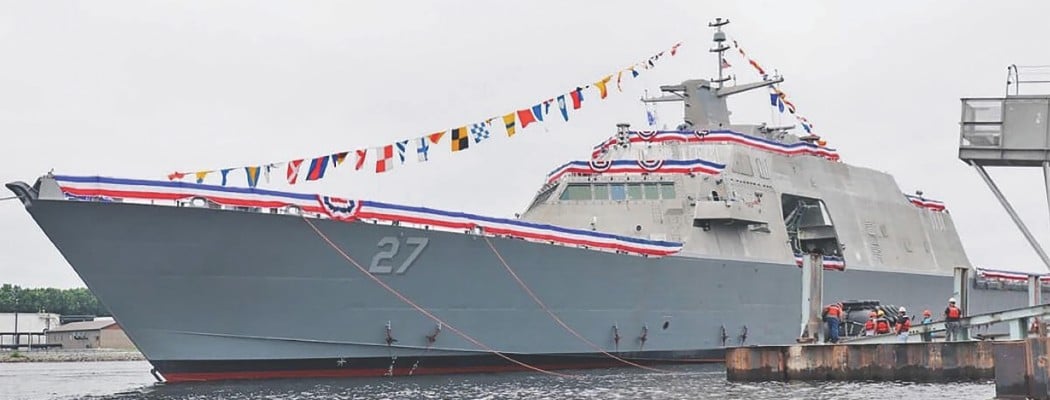Meet the new commander of the USS Nantucket.
In the 246-year history of the United States Navy, it wasn’t until 1993 that women were allowed to serve aboard warships. It would be another five years before a woman became a combat commander. Today, there’s a growing cadre of female commanders. This year alone saw a number of firsts, including the first female to take command of a nuclear-powered aircraft carrier as well as the first time four women of color were made commanders in the same year. The island now shares in this emerging chapter of naval history thanks to the first commander of the newly christened USS Nantucket, thirty-eight-year-old Kari Yakubisin.

“There are more women in command every year than there used to be,” said Yakubisin, who was on the island this past September for the unveiling of the crest of the Nantucket at the Whaling Museum and the Great Harbor Yacht Club. “As more women join the military, then naturally over time you have more that reach that rank.”
In Yakubisin’s case, no one could have predicted that she would end up in the Navy— let alone command a warship. Though she grew up near the coast in California, she didn’t spend any time on the water. No sailing, no fishing—not even surfing. Nor was military service a family pastime. Apart from her grandfather serving in the Navy during World War II, most of Yakubisin’s relatives worked civilian jobs. After her family moved to Portland, Oregon, she graduated from an all-girls high school and planned on studying medicine in college.

But while touring a college campus with a Navy Reserve officer, Yakubisin became engrossed with his stories of the Navy and ultimately decided to change course. “Part of the appeal was the adventure of the Navy,” she explained. “They say, ‘Join the Navy and see the world.’ I thought the Navy was a great opportunity to branch out on my own from my parents, and to serve a greater purpose.” Yakubisin enrolled in Vanderbilt University where she joined the Navy ROTC and majored in molecular and cellular biology, still planning on becoming a doctor, except for the Navy. “But then I decided I wanted to be on ship instead.”

Despite her lack of experience on the water, Yakubisin proved to be a natural in the Navy and rose up the ranks quickly. Commissioned as an ensign in 2005, her first job was as the electronic warfare officer on LPD-15. “In that tour I learned how to drive a ship, qualified as officer of the deck, and learned how to lead a division of ten people,” she said. “I also received my surface warfare officer warfare device, which is a certification that you have demonstrated the experience and requisite knowledge to proceed in your career.”
And proceed she did. Three years after being commissioned as an ensign, Yakubisin completed Nuclear Power School, enabling her to work on aircraft carriers and submarines. She then received her master’s in engineering management. Her time on the water included tours aboard the USS Ponce, USS Ronald Reagan, USS John Paul Jones and the USS George H.W. Bush. She racked up awards and commendations, including the Meritorious Service Medal, the Navy and Marine Corps Commendation Medal and the Navy and Marine Corps Achievement Medal. Currently serving as the second in command on the USS Milwaukee, Yakubisin has acquired the skills and experience to command a ship of her own. She will assume her command of the Nantucket sometime at the end of next year, after the final construction is completed.
At 378 feet long and drawing around fourteen feet of water, the Nantucket is a Freedom-variant littoral combat ship designed to navigate coastal waters that bigger vessels cannot. Armed with Rolling Airframe Missiles and a Mark 110 gun that fires 220 rounds per minute, the vessel will be as lethal as it is agile. “It was built as a multi-mission-capable unit with the ability to quickly swap between surface warfare, mine warfare and anti-submarine warfare,” explained Yakubisin. “With a crew of 73 personnel, missions range from countering drug operations utilizing SH-60S helicopters and UAVs [unmanned aerial vehicles] to countering small boat attacks with 30 mm guns.”

On a gray day this August, Nantucket resident Polly Spencer walked up a steep gangway to the prow of the ship sitting in dry dock in Marinette, Wisconsin. Spencer—the wife of the seventy-sixth Secretary of the Navy, Richard V. Spencer—then hoisted a champagne bottle and broke it across the bow. In dramatic fashion, the war vessel slid sideways, splashing into the Menominee River and marking the first chapter for the Nantucket. It’s the third vessel in Navy history to be named Nantucket, the first of which was commissioned in 1833 during the Civil War.
One might think that being put in command of a multimillion-dollar warship would be intimidating to say the least, but Yakubisin discusses her new post with the emotionless tenure of the career military person she is. “We train for almost every situation,” she said. “Part of being selected for the command is that you’ve proven already that you can make those decisions. All of the training up to this point in my career has set me up for success.” For two years at a time, Yakubisin eats, sleeps and breathes Navy life. “We say the end of the work day here is 1500, but it’s a twenty-four-hour, seven-day-a-week, 365-day-a-year job,” she said.

But the demands of her career have not prevented her from creating a civilian life off the water. Yakubisin has been married for fifteen years. Between tours aboard ship, she has two-year shore duties, which allows her to maximize her time with her husband and extended family and friends. Her life is not unlike those of the old Nantucket whalers, spending years at sea before returning home with their stories from offshore.
 “I feel a sense of responsibility to stay in the Navy so that younger female officers and sailors have a mentor to discuss their personal and professional goals,” Yakubisin said. “The second part is the satisfaction when those same people choose to stay in this profession. Regardless of gender, military service is a sacrifice that you and your family make. It’s not the right profession for everyone, but as we recruit more women each year, the numbers of females in higher ranking positions will continue to increase.” And they’ll have commanders like Kari Yakubisin to lead them forward.
“I feel a sense of responsibility to stay in the Navy so that younger female officers and sailors have a mentor to discuss their personal and professional goals,” Yakubisin said. “The second part is the satisfaction when those same people choose to stay in this profession. Regardless of gender, military service is a sacrifice that you and your family make. It’s not the right profession for everyone, but as we recruit more women each year, the numbers of females in higher ranking positions will continue to increase.” And they’ll have commanders like Kari Yakubisin to lead them forward.







